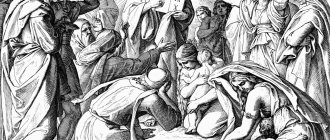The Bible, or Holy Scripture, is rightly called the “book of books”; it has been translated into different languages of the world and is still published in large editions, since interest in it never fades. Someone who was previously an atheist can believe in God, and then he studies not only church canons, but also spiritual literature.
There are many books on theology, and a newly converted Christian finds out for himself that the Holy Scriptures are very voluminous, and asks the logical question of what the Bible consists of (after all, previously it was thought that it was a small book).
In fact, the Holy Scriptures have their own structure. The Bible is first of all divided into 2 large parts, according to the time of writing: before the birth of Christ (Old Testament) and after (New Testament).
Old Testament
A covenant is a union, in this case, the union of a person with God. The Old Testament describes prophecies about the coming of the Messiah, as well as God's instructions to people, transmitted through preachers.
The book begins with a description of the creation of the world and the Fall, then there is a story about the life of the children of Adam and Eve, the sin of Cain’s fratricide of Abel and the further life of subsequent generations. After the first fall, when the serpent tempted Eve to taste the forbidden fruit, and then Adam was tempted, humanity also learned other vicious acts and continues to live in sin.
In the well-known story of the Old Testament, the Lord appeared to the prophet Moses on Mount Sinai and ordered him to keep the 10 commandments (written on stone tablets) and carry them to the people. With the help of these instructions, God gives the Jews a guide to a righteous life. However, there are still those who are unwilling to humble their whims, trust God and build a bright Orthodox future. People do not understand that all troubles do not come from external forces, but are the result of their own actions and thoughts.
In general, the Old Testament is aimed at Jews and is written mostly in their language, some in Aramaic. Later Old Testament materials contain Assyrian and Babylonian words, and 3 Ezra was written in Latin.
The period from the prophet Moses (1550 BC) to Samuel (1050 BC) should be considered the first period of the creation of the Holy Books.
The written revelations and laws were put into the Ark of the Covenant (a special chest that God himself commanded to be used to store the commandments).
The Old Testament part of the Bible consists of several types of books:
- The Pentateuch of Moses, otherwise the Torah (Genesis, Exodus, Leviticus, Numbers, Deuteronomy);
- historical books;
- teaching;
- prophetic writings;
- non-canonical books.
Before printing began, stories were written on papyrus or parchment with a reed dipped in ink. Books were then called charters and were presented in the form of scrolls wound on a shaft.
Later, the sheets began to be divided into sheets and sewn together, which was more like modern books. However, back then there were no uppercase or lowercase letters, spaces between words, or punctuation marks, so it was difficult to read continuous text made up of capital letters.
By the way, the Hebrew language had no vowels at all.
What language is the Bible written in?
The first chapters were written in the language of the ancient Jews - Hebrew. The texts compiled during the life of Jesus Christ were written in Aramaic.
For the next few centuries, the Word of God was written in Greek. Seventy interpreters were involved in the translation into Greek from Aramaic. Servants of the Orthodox Church use texts translated by interpreters.
The first Slavic Holy Scripture was translated from Greek and is the first book to appear in Rus'. The translation of the sacred meetings was entrusted to the brothers Cyril and Methodius.
During the reign of Alexander I, biblical texts were translated from Slavic into Russian. Then the Synodal translation appeared, which is also popular in the modern Russian Church.
New Testament
The creation of all New Testament books dates back to the 1st century AD.
"Gospel" means "good news." This is the name of the first 4 books of the New Testament, which tell about the life of Jesus Christ, his mission, sermons, martyrdom and miraculous resurrection. The teaching of Jesus is the “good news” about the possible salvation of sinful humanity.
The gospels of Matthew, Mark, Luke and John are known and accepted. They all talk about Christ, but in slightly different ways. The Gospels of Matthew, Mark and Luke are considered synoptic, that is, presented in a single image. The Gospel of John is distinguished by a more emotional presentation of events and, rather, is intended not to talk about the life of Jesus, but to talk about the great meaning of faith in God. The facts and circumstances in the Gospels converge, but the angle of view of the story about the Savior is different. What is known is that the evangelists lived at the same time as Jesus and were closely acquainted with him or his apostles.
What is the meaning of the word “covenant” in different religions? The answer to this question is in our previous article at the link.
Gospel of Matthew
So, Matthew was originally a tax collector, that is, a tax collector, which means he was despised by his compatriots, like all the scribes, Pharisees and tax collectors. When he became one of the 12 apostles, he was named after Levi. Realizing the depravity of his previous existence, Matthew writes his Gospel for the Jewish people, emphasizes the origin of Jesus from David and Abraham and often refers to the Old Testament, wanting to convince everyone: Jesus is the Messiah, the prophecy has come true. Since the first Gospel was written for the Jews, Matthew does not explain the meaning of national traditions and rituals, and since he preached for a long time in Palestine, he does not translate the Aramaic words that were then used in that area.
Gospel of Mark
The Evangelist Mark was otherwise called John. He was not one of Christ’s close associates, but learned information about the life of the Savior from the Apostle Peter. After the death of the Apostle Paul, Mark became the first bishop of the Alexandrian Church. The Gospel of Mark was intended for Roman pagan Christians. It contains almost no references to the Old Testament and skips Christ's Sermon on the Mount. Mark places great emphasis in his narrative on the miracles performed by Jesus and emphasizes His greatness as the Son of God.
Gospel of Luke
According to legend, the Evangelist Luke was a doctor, a painter, and, in general, a pagan who later converted to Christianity. He belonged to the 70 disciples of Christ. Luke wrote the third Gospel, guided by the words of eyewitnesses to the events of that time and analyzing the then available records about Christ. In his Gospel, Luke focuses on the fact that Jesus is the Savior of all people, including pagans.
The third evangelist was a friend of the holy preacher Paul and created the “Book of the Acts of the Apostles.”
Gospel of John
John the Theologian came from a wealthy fishing family. He was first a disciple of John the Baptist, and later of Christ himself. There was a warm relationship and trust between them: even on the cross, Jesus entrusted His Mother to John. He accepted Christian love more deeply, and his story about the deeds of the Savior is permeated with delight and reverence. The Gospel of John convinces us of the need to love every neighbor through the Lord.
There are Gospels by other authors, about 50 in total, which the Church has called apocryphal and unreliable.
Book of Acts and Council Epistles
These works continue the stories of the Gospel and tell about the godly deeds of the apostles. In their books they answer all sorts of questions about the Christian faith, ethical aspects and practices. This was the time of the formation of Christian communities.
The Book of Acts talks about the Resurrection of Christ and His Ascension into heaven. The story ends with the appearance of Paul in Rome, where he preached Christianity for 2 years.
The 7 Catholic Epistles were created by the apostles of Jesus: James, Peter, Judas (not Iscariot), as well as John the Theologian and contain general religious and moral teachings.
Apocalypse
Apocalypse (Revelation) is a prophetic book of John the Theologian. Here he talks about the soon coming of the Messiah again. The future of humanity awaits the end of this world and the beginning of a new, eternal one, where everyone will receive what they “earned” during earthly life through their actions and thoughts. Revelation shows the struggle of the Church with the forces of evil, the devil’s ways of tempting believers and seducing them from the true path, and also calls for the eradication of their sins, and ultimately the victory of Christ over evil.
The result of humanity is the Judgment of God, where the fate of everyone will be decided, from the very beginning of time.
The book Apocalypse was written not in chronological order, but in such a way as to show more clearly and vividly the essence of the struggle between good and evil and the prospects for those living on Earth after the Judgment.
You can read about contradictions in the Bible here.
History of the Bible
The Bible was written over fifteen centuries. It was written in letters, although early peoples used hieroglyphs and cuneiform for writing, i.e. depicted a story.
The Bible is divided into two parts: the Old (old) Testament and the New Testament (Gospel - “good news”). The books of the Old Testament were written in Hebrew, in the Phoenician alphabet, with capital consonants expressing the essence of the word. The books were written on scrolls made of tanned leather, using sharpened reeds and ink.
The words were not always separated from each other, much less there were chapters and verses. All books of the New Testament were written in ancient Greek. In 1228, Archbishop Stephen Langton created the chapter system, and in 1551, the Parisian Bible publisher Robert Etienne divided the chapters into verses.
The biblical text was written on three continents: Europe, Asia and Africa. About 45 people wrote the Bible. They had different origins, different status in society, and professions. Among them were: fishermen, military leaders, prophets, kings, shepherds, a tent maker, a doctor, a tax collector, etc. They differed from each other in culture, education, and abilities.
Of course, the author of the Bible is God Himself, but it was written by people under the influence of God’s Spirit, as we can read about in 2 Peter 1:19-21
“And moreover, we have a most sure prophetic word; and you do well to turn to him as to a lamp shining in a dark place, until the day dawns and the morning dawns in your hearts, knowing first of all this, that no prophecy in Scripture can be resolved (“created”). by yourself. For prophecy was never made by the will of man, but holy men of God spoke it, being moved by the Holy Spirit.”
God Himself, through His Spirit, gave His chosen people the ability to receive revelation from Him and, using their individuality, their style of expression, their language, spoke and wrote down His revelation to humanity through these people. But not only were the writers moved by the Spirit, the very text of Scripture breathes it, as we can see for ourselves by reading this book today.
What parts does the Bible consist of?
Biblical texts are divided into canonical and non-canonical parts. Non-canonical ones include those that appeared after the creation of the New Testament.
The structure of the canonical part of Scripture includes:
- legislative: Genesis, Exodus, Deuteronomy, Numbers and Leviticus;
- historical content: those that describe the events of holy history;
- poetic content: Psalms, Proverbs, Song of Songs, Ecclesiastes, Job;
- prophetic: writings of great and minor prophets.
Non-canonical texts are also divided into prophetic, historical, poetic and legislative.
Why is this the Holy Book of Christians
The Bible is not just a holy book. This is a handwritten source of human spirituality. From the pages of Scripture people draw wisdom sent by God. The Word of God is a guide for Christians in their worldly life.
Through Biblical texts the Lord communicates with people. Helps you find answers to the most difficult questions. The books of the Holy Scriptures reveal the meaning of existence, the secrets of the origin of the world and the definition of man's place in this world.
By reading the Word of God, a person comes to know himself and his actions. Becomes closer to God.











